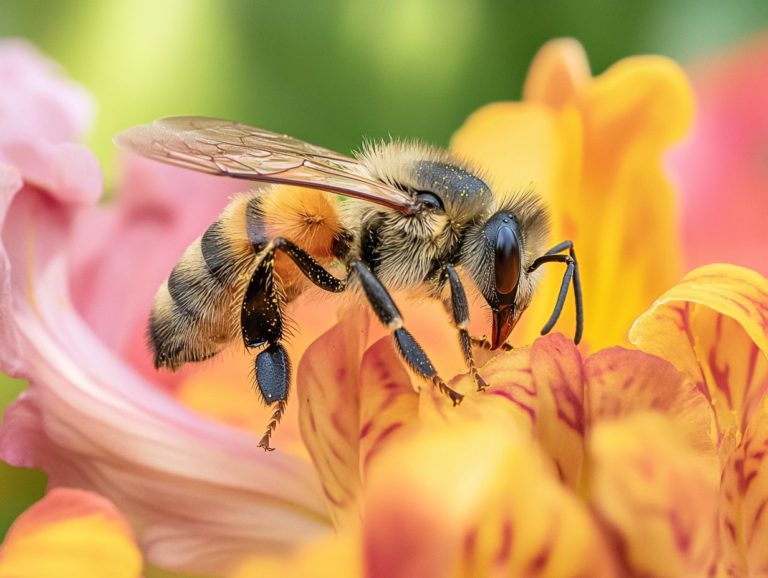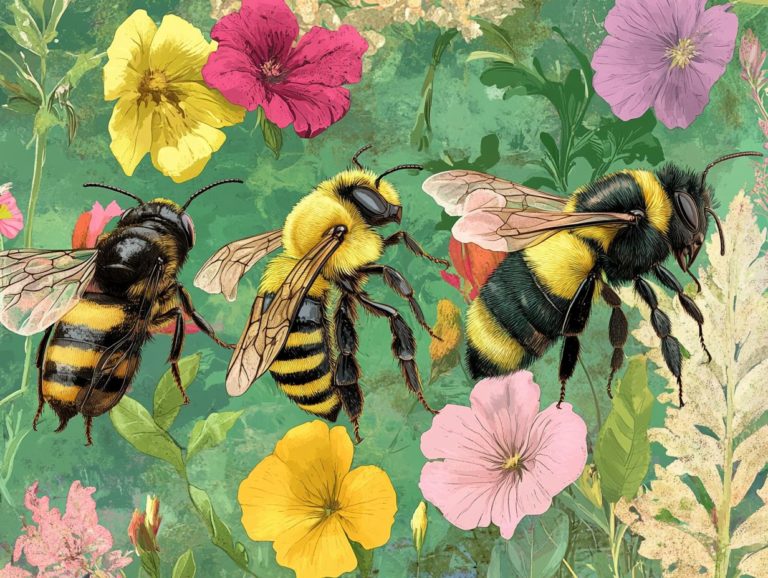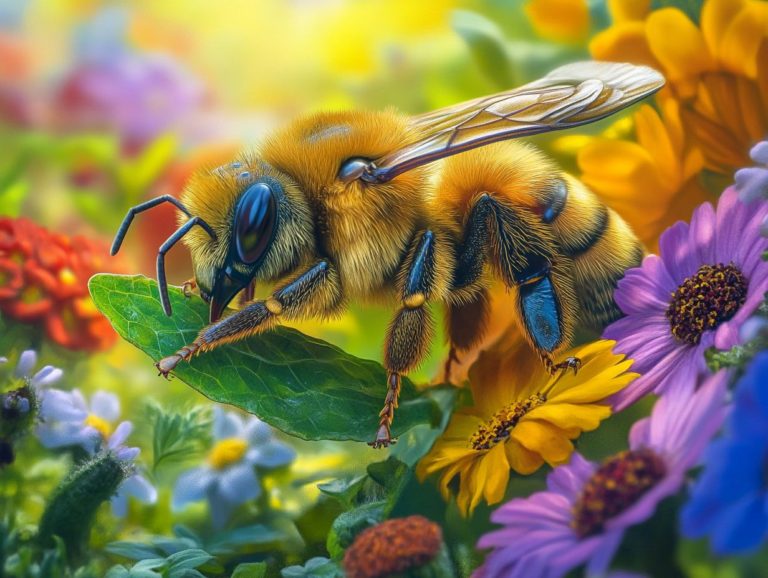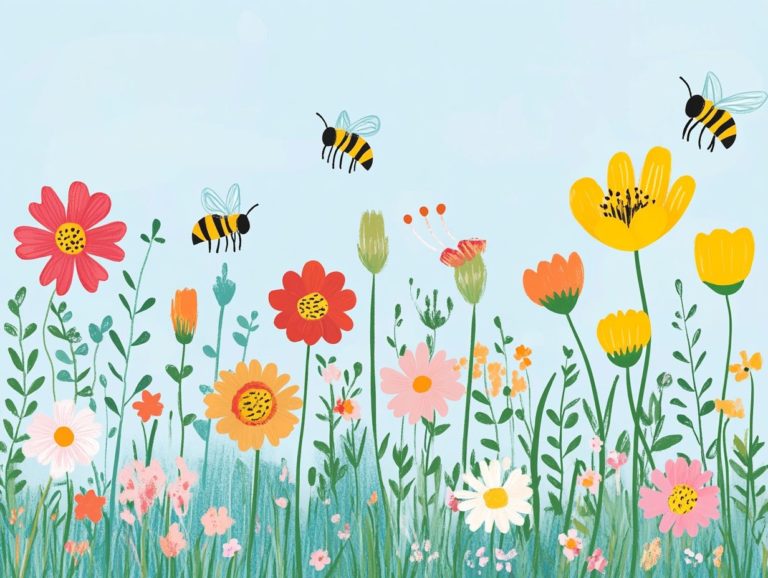The Importance of Bees in Pollination
Pollination is a critical process that sustains ecosystems, and bees are at the forefront of this essential activity. These remarkable insects are pivotal for the reproduction of numerous plants, forming the backbone of global food production. The importance of pollination services also extends to wildlife, supporting the interconnected web of life.
You will explore the intricate relationship between bees and the flora they nurture. Delving into the threats posed by climate change, habitat loss, and pesticides, this article emphasizes the actions you can take to protect these vital creatures, such as supporting habitat restoration and sustainable management practices.
Understanding why we need to protect pollinators is vital for both the environment and the economy, empowering you to make a difference.
Join us in discovering how bees shape our ecosystems!
Contents
- Key Takeaways:
- Why Pollination Matters
- What are Bees?
- Why are Bees Important for Pollination and Crop Production?
- What are the Threats to Bee Populations and Pollinator Services?
- How Can We Protect Bees and Pollination?
- What are the Benefits of Protecting Bees and Pollination?
- Frequently Asked Questions
- What is pollination and why is it important?
- How do bees contribute to pollination?
- What are the benefits of bees in pollination for humans?
- How does the decline of bee populations affect pollination?
- What are the main threats to bee populations and pollination?
- What can we do to protect bees and promote pollination?
Key Takeaways:

- Bees play a crucial role in pollination, which is essential for the growth and reproduction of many plants that humans and animals depend on for food. The USDA and other organizations emphasize the importance of conserving pollinators to maintain ecological balance.
- There are over 20,000 species of bees, each with a unique role in pollination, making them crucial for biodiversity.
- The decline in bee populations due to climate change, habitat loss, and pesticide use poses a threat to our food supply and the environment. Protecting bees is vital for their survival and the health of our planet.
Why Pollination Matters
Pollination is an essential biological process that involves transferring pollen from the parts of the flower that produce pollen to the parts of the flower that receive it, enabling fertilization and the production of seeds. This intricate relationship is not only vital for the reproductive success of many plants but also plays a pivotal role in maintaining biodiversity within ecosystems.
Various species, including bees, butterflies, and even bats, contribute to this natural phenomenon by moving pollen while they seek nectar. By doing so, they ensure the production of fruits, vegetables, and other crops that are crucial for food security and the global economy.
Why is Pollination Important?
Pollination is absolutely vital for producing about 75% of the world s food crops, making it an essential process for sustaining human life and ensuring economic stability.
This intricate biological dance not only nurtures a diverse range of fruits, vegetables, and nuts but also significantly impacts the global economy, contributing billions of dollars to agricultural output. Essential crops like almonds, berries, and cucumbers rely heavily on animal pollinators such as bees and butterflies.
The troubling decline in pollinator populations presents urgent risks to food security, jeopardizing both crop yields and biodiversity.
Without adequate pollination, farmers could face decreased harvests, leading to soaring food prices and a worrying scarcity of vital nutrients in diets around the globe. This highlights the economic importance of maintaining healthy pollinator populations for food security and community well-being.
What are Bees?
Bees represent an extraordinary and diverse group of flying insects within the superfamily Apoidea, boasting over 20,000 recognized species across the globe. These insects include wild bees and other native pollinators. Their role in ecosystems is nothing short of essential, acting as pivotal pollinators that enhance the reproductive success of numerous plants, including crucial agricultural crops and native flora.
While bees are famously known for their honey production, which holds significant ecological and economic importance, their contributions extend far beyond this sweet byproduct. These remarkable pollinators flourish in a variety of habitats, ranging from urban gardens to untamed natural landscapes, thereby nurturing biodiversity and bolstering vibrant ecosystems. Awareness and education about the role of bees can help foster community support for conservation efforts.
Take action today by planting bee-friendly flowers or supporting local beekeepers to help preserve these essential pollinators!
What is the Role of Bees in Pollination?
Bees play a crucial role as vital pollinators, skillfully transferring pollen from flower to flower while collecting nectar. This process is essential for the reproduction of countless plant species, including many crops that are significant to the economy.
Their foraging behavior is nothing short of extraordinary; bees traverse extensive areas, visiting hundreds of flowers each day. This complex movement not only guarantees the successful fertilization of plants but also promotes genetic diversity, creating a variety of plants that are healthier and can grow better in different conditions. This results in stronger crops.
Bees also help maintain healthy natural habitats, fostering biodiversity and stabilizing ecosystems. Wild bees, butterflies, and even bats also contribute to this fundamental process, ensuring the broad pollination required for robust ecosystems.
By aiding in the production of fruits, nuts, and vegetables, bees bolster food security and agricultural livelihoods. Their impact goes far beyond crop production. The decline in bee populations is a growing concern that we must address now, underscoring their irreplaceable value in both agriculture and the environment.
How Many Species of Bees and Pollinators are There?
With over 20,000 documented species of bees worldwide, you are witnessing an extraordinary array of diversity that plays a crucial role in biodiversity and the health of ecosystems.
Bees fall into two main categories: solitary and social types. Solitary bees, like mason bees and leafcutter bees, tend to live independently, often favoring specific habitats such as gardens or meadows where they can find the perfect nesting resources. On the other hand, social bees, including honeybees and bumblebees, thrive in colonies, collaborating to efficiently pollinate a wide range of plants. Each species possesses unique adaptations that allow them to flourish in various climates and conditions.
This remarkable variety not only facilitates the pollination of numerous crops and wild plants but also underscores the urgent need for their conservation. Protecting these vital creatures is essential for maintaining ecological balance and ensuring the sustainability of our food systems.
Why are Bees Important for Pollination and Crop Production?

Bees rank among the most vital pollinators, playing a crucial role in the pollination of about one-third of the food you consume. This includes a diverse array of fruits, vegetables, and nuts that are essential for maintaining a balanced diet.
Their tireless work ensures that your meals are not just nutritious but also delicious. Diverse pollination techniques and strategies employed by bees also contribute to the quality and yield of these crops.
What Plants Depend on Bees for Pollination?
Many plants rely on bees for effective pollination, including a variety of fruits such as apples, almonds, and cherries, along with vegetables like cucumbers and zucchini. This makes bees absolutely essential for agricultural productivity. The yield and quality of these plants are significantly improved through the pollination services provided by bees.
Beyond these familiar crops, other notable examples include blueberries, cranberries, and various nuts that thrive thanks to the diligent efforts of bees. Other essential plants include cocoa and coffee, which are vital for the global economy. The presence of these pollinators not only increases the quantity of produce but also enhances its quality, resulting in larger, more flavorful fruits and vegetables.
A decline in bee populations could lead to lower yields and reduced food quality, affecting both farmers’ livelihoods and food security in communities. Without bees, many of our favorite foods could disappear! We must protect these crucial pollinators, ensuring that diverse crops continue to thrive and support our growing population.
How Do Bees Pollinate Plants?
Bees play a vital role in pollinating plants by transferring pollen grains from the male anther of one flower to the female stigma of another. This detailed process often begins as they gather nectar for nourishment.
By doing so, they facilitate the reproductive journey of the plants. The seasonal activity of bees aligns with the flowering times of many herbaceous and flowering plants, ensuring effective pollination.
As you observe bees foraging for nectar essentially their primary source of energy you ll notice how they inadvertently become essential agents of fertilization for flowering plants. Each time they visit a flower, these diligent creatures collect vibrant pollen on their bodies, which they then carry to the next bloom, ensuring effective cross-pollination, which means transferring pollen between flowers to help them reproduce.
This interaction is vital for plant reproduction and must be protected to ensure a thriving ecosystem. It also promotes genetic diversity, ultimately leading to more resilient plant populations.
In return, the plants produce nectar, a sugary reward that serves to entice bees, fostering a symbiotic relationship where both parties flourish.
Such cooperation is foundational to the health of ecosystems and the productivity of agriculture, underscoring the intricate balance of nature that sustains life.
What are the Threats to Bee Populations and Pollinator Services?
It s crucial to understand that bee populations face serious threats that endanger their survival and, in turn, the essential pollination services they offer. Key threats include habitat loss, pesticide exposure, and the far-reaching impacts of climate change.
How Does Climate Change Affect Bees and Pollination?
Climate change presents formidable challenges for bees, affecting their habitats, foraging behaviors, and the critical timing of flowering plants all of which disrupt the intricate balance required for successful pollination. Initiatives by organizations like the Xerces Society and Kew Gardens are critical in raising awareness and promoting strategies for bee conservation.
As global temperatures rise and weather patterns grow increasingly unpredictable, the synchronization between bees and flowering plants becomes chaotic. This misalignment can force bees to emerge from hibernation either too early or too late, missing the peak blooming times of their food sources.
Habitat fragmentation from urban development and agricultural expansion worsens the situation, shrinking the foraging areas available to bee populations. As a result, the decline in bee numbers jeopardizes essential pollination services vital for food crops, negatively impacting agricultural yields, biodiversity, and the global economy.
This, in turn, can lead to catastrophic consequences for ecosystems that rely on both plants and pollinators, including other insects such as butterflies and bats.
What Are the Effects of Pesticides on Bees and Pollination?
The use of pesticides in agriculture directly threatens bee populations, including wild bees, leading to declines that disrupt vital pollination services essential for food production, the stability of ecosystems, and the sustainability of the global economy.
This disruption in bee health and behavior can have cascading effects on entire ecosystems, as these invaluable pollinators are responsible for fertilizing a significant portion of the crops you rely on, including fruits, vegetables, nuts, and cocoa.
Bees exposed to harmful chemicals may struggle with impaired navigation skills, reduced foraging efficiency, and weakened immune systems, making them more vulnerable to diseases and environmental stressors.
The consequences of declining bee populations are alarming; they disrupt natural habitats and threaten food production. They put at risk plant species and wildlife that depend on these crucial pollination processes.
To mitigate these effects, it s essential for you to adopt sustainable agricultural practices, such as integrated pest management and organic farming, preserving not only bee health but also the overall vitality of our ecosystems and agricultural landscapes.
Join the movement to adopt sustainable practices and protect our bees!
How Can We Protect Bees and Pollination?

To safeguard bees and the vital pollination services they offer, it is essential for you to raise awareness and embrace sustainable practices methods that do not harm the environment that nurture their habitats, including planting native plants and fostering biodiversity.
By taking these steps, you contribute to a healthier ecosystem and ensure the continued prosperity of these remarkable creatures.
What Can Individuals Do to Help Protect Bees?
You can play a crucial role in protecting bee populations by creating bee-friendly gardens, planting native plants, and raising awareness about the importance of pollinators in your local community, including hosting pollinator workshops.
By reducing pesticide use and opting for organic gardening methods, you can establish a safe haven for these essential insects. Supporting local beekeepers not only contributes to the sustainability of bee populations but also fosters a meaningful connection between you and local agriculture, enhancing the quality of honey and other pollinator services.
Engaging in community initiatives such as tree planting events or pollinator workshops can amplify your impact and inspire others to join the cause. Each of these small, intentional actions nurtures local ecosystems and contributes to the health of our planet, highlighting just how interconnected our actions truly are, particularly in spring when many plants and pollinators are most active.
What Steps are Governments and Organizations Taking to Protect Bees?
Governments and organizations around the globe are actively protecting bees with various strategies, including policies focused on habitat restoration, pesticide regulations, and community engagement initiatives aimed at raising awareness. These strategies include assessments and education on sustainable agricultural practices.
These efforts are crucial because bees are essential to crop pollination and ecosystem support. Organizations such as the Xerces Society are leading the charge, advocating for sustainable farming practices while tirelessly promoting the preservation of pollinator habitats, ensuring the continued production of crops like almonds and coffee.
The U.S. Department of Agriculture (USDA) has also stepped up with initiatives that offer technical assistance to farmers, encouraging them to embrace pollinator-friendly farming methods, such as the cultivation of native plants and seasonal herbaceous plants.
Take successful examples like California’s almond orchards, where farmers and conservation groups have joined forces to enhance bee habitats. These collaborations highlight the profound impact that such partnerships can have, contributing to the sustainability of both agricultural and natural ecosystems.
By fostering cooperation among various stakeholders including government, industry, and community members you can contribute to meaningful changes that safeguard bee populations for future generations and ensure the diversity of our crops and food supply.
What are the Benefits of Protecting Bees and Pollination?
Protecting bees brings incredible benefits! By fostering enhanced biodiversity, you play a vital role in boosting food production and economic stability, creating a healthier environment for all living organisms, including wildlife and plant species.
Embracing this responsibility not only supports the ecosystem but also enriches the quality of life for everyone, emphasizing the importance of pollinators like bees, butterflies, and bats in maintaining our environmental and economic wellbeing.
How Does Protecting Bees Benefit the Environment?
Protecting bees offers significant benefits to the environment by enhancing biodiversity and fostering healthy ecosystems. These remarkable insects play a crucial role in the reproductive success of numerous plants, including both agricultural crops and wildflowers.
Their vital role in transferring pollen ensures that fruit and seed production flourishes, influencing the broader dynamics of plant communities. Without these industrious pollinators, many native plants would struggle to reproduce, leading to a decline in plant diversity and the availability of important resources for other wildlife.
This decline impacts the animals that depend on those plants for food, shelter, and habitats, creating a ripple effect throughout the ecosystem. Healthy bee populations serve as indicators of ecosystem health, highlighting the critical connections that maintain biodiversity, including the intricate web of life that sustains us all.
Thus, protecting these essential pollinators is imperative for preserving the intricate web of life and ensuring the stability of our ecosystems.
What Are the Economic Benefits of Protecting Bees and Pollination?
The economic advantages of safeguarding bees and the invaluable process of transferring pollen they provide are substantial. They directly influence the growth and sustainability of agriculture, which is crucial for the global economy, especially in the production of crops like almonds, coffee, and cocoa.
Bees are essential for the pollination of over 75% of the world’s flowering plants, including many crops that are vital for human consumption. Their decline could lead to decreased crop yields, soaring food prices, and compromised food quality, affecting the economic stability of communities that rely on agriculture.
Take, for instance, a study by the USDA that estimates bees contribute a staggering $15 billion to crop production each year in the United States alone. The agricultural sector relies heavily on these industrious pollinators; approximately 2 million jobs in the U.S. are tied to agriculture that depends on bee activity. This emphasizes the importance of maintaining robust bee populations.
By ensuring robust bee populations, you re not only supporting crop diversity but also providing a major boost to the economy, safeguarding agricultural livelihoods, and promoting stability in culturally significant agricultural practices.
Frequently Asked Questions

What is pollination and why is it important?
Pollination is the transfer of pollen from the male part of a flower to the female part, which leads to fertilization and the production of seeds. This process is crucial for the reproduction and survival of many plant species, making it essential for maintaining biodiversity and ecosystem stability. Bees, butterflies, and bats play significant roles in this process.
How do bees contribute to pollination?
Bees play a major role in pollination, as they are responsible for pollinating over 70% of the world’s plant species. They collect pollen and nectar from flowers to feed themselves and their offspring. In the process, they unintentionally transfer pollen between flowers, aiding in fertilization. Honey produced by bees is a byproduct of this essential activity.
What are the benefits of bees in pollination for humans?
The benefits of bees in pollination for humans are numerous. Bees help to produce about one-third of the food we eat, including fruits, vegetables, nuts, and seeds. They also contribute to the production of fibers such as cotton and flax, which are used to make clothing and other products. They also play a critical role in maintaining the health of our ecosystems.
How does the decline of bee populations affect pollination?
The decline of bee populations can significantly impact pollination. With fewer bees available to pollinate crops and plants, there will be a decrease in the production of fruits and vegetables. This can lead to food shortages and higher prices, affecting both human and animal populations, and causing a decline in food quality and yield.
Join us in supporting local beekeepers and planting bee-friendly gardens!
What are the main threats to bee populations and pollination?
Bee populations face serious threats from various factors. These include loss of places where bees live, harmful pesticide use, diseases, and climate change.
Such threats disrupt the natural balance of bees and their vital role in pollination. This can lead to significant problems in ecosystems, including colony collapse disorder.
What can we do to protect bees and promote pollination?
You can play a vital role in protecting bees and boosting pollination! Simple steps include planting flowers that attract bees and creating spaces where they can thrive.
Avoid using harmful pesticides and support your local beekeepers. Raising awareness about how essential bees are to our environment makes a big difference.
Creating gardens that offer nectar and pollen helps bees thrive. Let’s work together to ensure a brighter future for these crucial pollinators!






